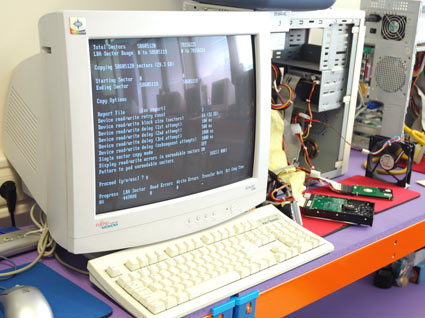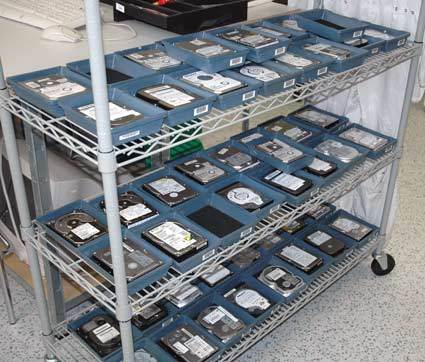Saving Your Data After a Head Crash: An Inside Look at a Disk Recovery Service
Here's To A New One: Hard Disk Clones
After the manual correction CBL tries to duplicate the hard disk contents on another drive. And they even manage to do that with the help of its own software. It's incredible: Our notebook hard disk came away with only 240 read errors following the head crash. Therefore, it was possible to recover a whopping 99.9% of the saved data. By the way, CBL doesn't use the damaged hard disk after the cloning procedure.
CBL has a nice selection of possible drives available for duplicating the hard disk contents.
Recovery: If You're Going To Do It, You Might As Well Go The Whole Hog
After the data is copied from the damaged disk, the cloned disk is connected to a lab computer. Then they check to see if the partitions still exist. The data storage device is searched for file information using special software from CBL. Files that had already been deleted are also recovered, among other things. This process takes advantage of the fact that hard disks don't actually ever delete data contents. Rather, they simply mark them as free sectors which can be used again.
Danger: Fragmentation
Fragmentation refers to the saving of individual files in various pieces. For instance, this happens when several small files are deleted, followed by the saving of a larger file using the now free sectors of the smaller files. If individual files are "in pieces" spread over the disk, then the hard disk has to carry out additional head movements in order to completely read the file.
Consequently, regular de-fragmentation of the hard disk not only makes for quicker reading of files, it also improves the chances for data recovery - especially if really large, heavily fragmented files are involved. For instance, if the MFT (Master File Table with NTFS) is destroyed and data can only be read sequentially, then recovery is rarely possible without using the highest intelligence.
Get Tom's Hardware's best news and in-depth reviews, straight to your inbox.
Current page: Here's To A New One: Hard Disk Clones
Prev Page Hard Disk Surgery Next Page Reconstruction Check
Patrick Schmid was the editor-in-chief for Tom's Hardware from 2005 to 2006. He wrote numerous articles on a wide range of hardware topics, including storage, CPUs, and system builds.

